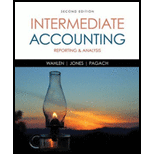
1.
Calculate the amount of pension expense of Company S for 2016 and 2017.
1.
Explanation of Solution
Pension plan: Pension plan is the plan devised by corporations to pay the employees an income after their retirement, in the form of pension.
Calculate the amount of pension expense of Company S for 2016 and 2017:
| Particulars | 2016 | 2017 |
| Amounts in ($) | Amounts in ($) | |
| Service cost | $147,000 | $153,000 |
| Add: Interest cost | $125,000 (1) | $152,200 (2) |
| Less: Expected return on plan assets | $0 | $33,000 |
| Add: Amortization of prior service cost (3) | $62,500 | $62,500 |
| Pension expense | $334,500 | $334,700 |
Table (1)
Working note (1):
Calculate the interest cost for 2016.
Working note (2):
Calculate the interest cost for 2017.
Working note (3):
Calculate the value of amortization of prior service cost for 2016 and 2017.
2.
Prepare the necessary journal entries of Company S for 2016 and 2017.
2.
Explanation of Solution
Prepare
| Date | Accounts Title and Explanation | Post Ref. | Debit ($) | Credit ($) |
| January 1, 2016 | Other comprehensive income: Prior service cost | 1,250,000 | ||
| Accrued/prepaid pension cost | 1,250,000 | |||
| (To record the beginning liability for prior service cost for 2016) |
Table (2)
- Other comprehensive income: Prior service cost is component of shareholders’ equity, and it decreases the value of shareholders equity. Hence, debit the other comprehensive income: Prior service cost account with $1,250,000.
- Accrued/prepaid pension cost is a liability account and it is increased. Therefore, credit the accrued/prepaid pension cost account with $1,250,000.
Prepare journal entry to record the pension expense for 2016:
In this case, Company S has underfunded the pension contribution by $4,500
| Date | Accounts Title and Explanation | Post Ref. | Debit ($) | Credit ($) |
| December 31, 2016 | Pension expense | 334,500 | ||
| Cash | 330,000 | |||
| Accrued/prepaid pension cost | 4,500 | |||
| (To record the pension expense incurred and its underfunded by $4,500) |
Table (3)
- Pension expense is component of shareholders’ equity, and it decreases the value of shareholders equity. Hence, debit the pension expense with $334,500.
- Cash is an asset account and it is decreased. Therefore, credit the cash account with $330,000.
- Accrued/prepaid pension cost is liability account and it is increased. Therefore, credit the accrued/prepaid pension cost account with $4,500.
Prepare journal entry to record the amortized prior service cost for 2016:
| Date | Accounts Title and Explanation | Post Ref. | Debit ($) | Credit ($) |
| December 31, 2016 | Accrued/prepaid pension cost | 62,500 | ||
| Other comprehensive income: Prior service cost | 62,500 | |||
| (To record the amortization of prior service cost) |
Table (4)
- Accrued/prepaid pension cost is an asset account and it is increased. Therefore, debit the accrued/prepaid pension cost account with $62,500.
- Other comprehensive income: Prior service cost is component of shareholders’ equity, and it increases the value of shareholders equity. Hence, credit the other comprehensive income: Prior service cost account with $62,500.
Prepare journal entry to record the pension expense for 2017:
In this case, Company S has overvalued the pension contribution by $15,300
| Date | Accounts Title and Explanation | Post Ref. | Debit ($) | Credit ($) |
| December 31, 2017 | Pension expense | 334,700 | ||
| Accrued/prepaid pension cost | 15,300 | |||
| Cash | 350,000 | |||
| (To record the pension expense overvalued by $15,300) |
Table (5)
- Pension expense is component of shareholders’ equity, and it decreases the value of shareholders equity. Hence, debit the pension expense with $334,700.
- Accrued/prepaid pension cost is asset account and it is increased. Therefore, debit the accrued/prepaid pension cost account with $15,300.
- Cash is an asset account and it is decreased. Therefore, credit the cash account with $350,000.
Prepare journal entry to record the amortized prior service cost for 2017:
| Date | Accounts Title and Explanation | Post Ref. | Debit ($) | Credit ($) |
| December 31, 2017 | Accrued/prepaid pension cost | 62,500 | ||
| Other comprehensive income: Prior service cost | 62,500 | |||
| (To record the amortization of prior service cost) |
Table (6)
- Accrued/prepaid pension cost is an asset account and it is increased. Therefore, debit the accrued/prepaid pension cost account with $62,500.
- Other comprehensive income: Prior service cost is component of shareholders’ equity, and it increases the value of shareholders equity. Hence, credit the other comprehensive income: Prior service cost account with $62,500.
3.
Explain the manner in which company S’s pension expense would differ, if the prior service cost was vested under IAS 19.
3.
Explanation of Solution
Explain the manner in which company S’s pension expense would differ if the prior service cost was vested under IAS 19 as follows:
When the prior service cost was vested, then Company S would consider the prior service cost of $1,250,000 as an expense under IFRS.
Want to see more full solutions like this?
Chapter 19 Solutions
Intermediate Accounting: Reporting and Analysis
 Intermediate Accounting: Reporting And AnalysisAccountingISBN:9781337788281Author:James M. Wahlen, Jefferson P. Jones, Donald PagachPublisher:Cengage Learning
Intermediate Accounting: Reporting And AnalysisAccountingISBN:9781337788281Author:James M. Wahlen, Jefferson P. Jones, Donald PagachPublisher:Cengage Learning Individual Income TaxesAccountingISBN:9780357109731Author:HoffmanPublisher:CENGAGE LEARNING - CONSIGNMENT
Individual Income TaxesAccountingISBN:9780357109731Author:HoffmanPublisher:CENGAGE LEARNING - CONSIGNMENT



